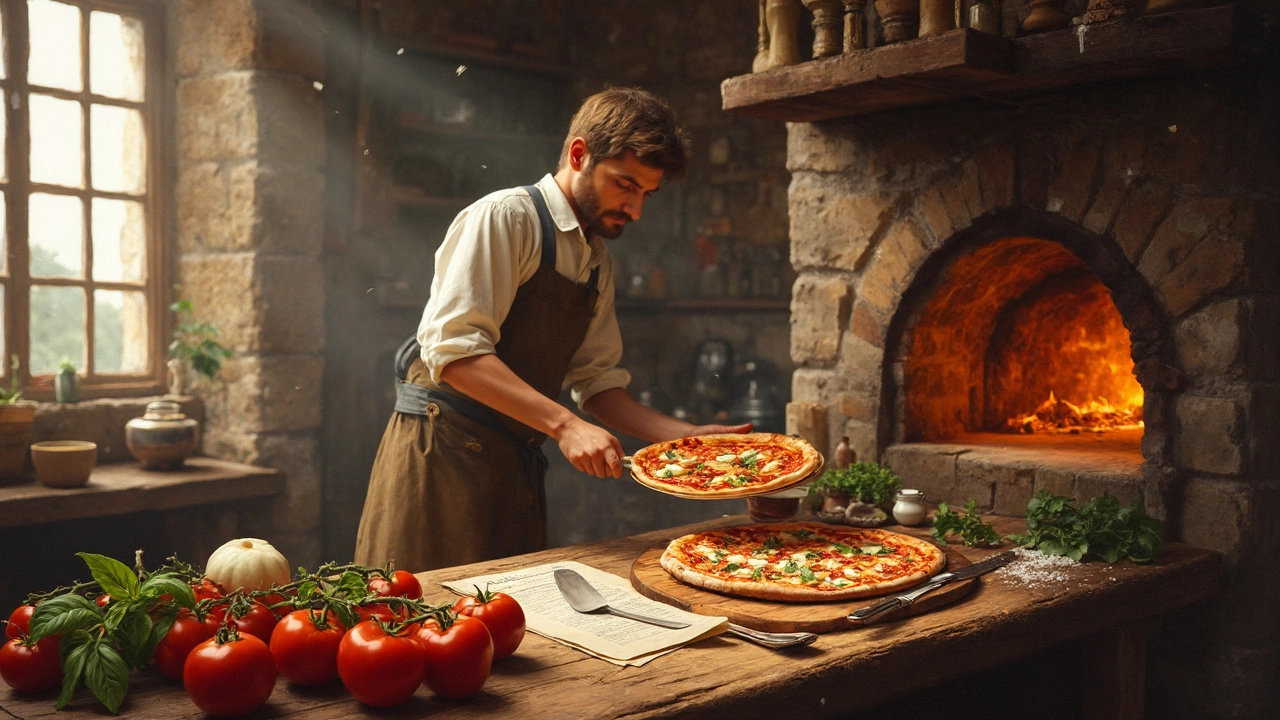
Ask anyone to name something Italian, and almost instantly, you’ll hear "pizza." But here’s the twist—Italy boasts a whole galaxy of signature dishes, all passionately defended by their home regions. Yet, pizza, especially the Neapolitan style, emerges over and over as Italy’s most iconic creation. Tourists fly across the world for just one authentic slice. Locals debate crust thickness over coffee like it’s a family legacy. So what is it about this round, saucy masterpiece that made it Italy’s poster child, and how did it end up on plates from Tokyo to Buenos Aires? Let’s slice through myths, travel back in time, and find out exactly why pizza is—and always will be—the dish that Italy can’t stop talking about.
The Birthplace: Naples and the Rise of Neapolitan Pizza
Long before pizza was folded into cardboard boxes or delivered by e-bikes, it was the humble meal of Naples’ working-class. Picture this: late 1700s, bustling alleys filled with vendors shouting over one another, and a bread topped with local ingredients to satisfy the city’s hungry poor. Tomatoes had just arrived from the New World and were still a curiosity, sometimes considered poisonous by the upper class. Naples took that gamble, slathered ripe tomatoes over flatbread, and the magic clicked. Mozzarella and fresh basil soon joined the family, and Margherita pizza was born, named (according to the legend) in honor of Queen Margherita’s visit in 1889. That classic tricolor—red tomato, white mozzarella, and green basil—mirrored the Italian flag. And no, nobody in 19th-century Naples expected it to snowball into an edible icon. But the combination of crisp-thin, chewy crust baked at 800°F in wood-fired ovens, and fresh toppings, was too good to keep local.
How serious are Neapolitans about pizza? Ask about the Associazione Verace Pizza Napoletana (AVPN)—this "True Neapolitan Pizza Association" sets standards stricter than most schools for their pizzas. The dough? No machines, only hands. The tomatoes? San Marzano, grown in volcanic soil near Mount Vesuvius. Ovens? Burning at precisely 485°C. Failure to meet any rule, and you’re not making "true" Neapolitan pizza. Even the hydration level of the dough and rising times are specified, like baking ledgers guarded by pizza monks. It’s both obsession and pride: pizza isn’t just a meal in Naples—it’s like a national anthem sung in flour and cheese.
Fast-forward to the 21st century. UNESCO named Neapolitan pizza a world heritage food in 2017, officially recognizing the craft as deserving of protection alongside ancient monuments. Every year, an estimated 8 billion pizzas are eaten worldwide (about 350 slices per second in the US alone!). Yet, Italians still know their slice from a mile away, and if you try pineapple or ketchup, you might get a lecture on tradition longer than the alphabet. Here’s a quick look at classic ingredients that make Neapolitan pizza famous:
| Ingredient | Region/Origin | Purpose |
|---|---|---|
| San Marzano Tomatoes | Campania, Italy | Sweet, slightly acidic, key for sauce |
| Buffalo Mozzarella (Mozzarella di Bufala) | Campania/Lazio | Rich, creamy cheese for authentic flavor |
| Fresh Basil | Italy-wide | Herbal freshness, aroma |
| 00 Flour | Italy | Silky texture, unique crumb |
| Extra Virgin Olive Oil | Italy-wide | Depth, rich finish |

Pizza vs. The Rest: Why Not Pasta, Risotto, or Tiramisu?
Now, some food historians gripe that Italy’s culinary heart actually beats for pasta. After all, there are hundreds of shapes across regions, with recipes cherished by grandmothers in candle-lit kitchens. Next door, creamy risottos in the north and hearty lasagna in Bologna could have easily claimed the title for Italy’s most famous dish—except they never inspired a worldwide following quite like pizza did. Italian pasta is deeply regional: carbonara belongs to Rome, trofie to Liguria, orecchiette to Puglia. But pizza broke free from its birthplace. It doesn’t matter if you’re eating it in Milan or Mumbai, Tokyo or Toronto—it’s the same recognizable idea: bread, sauce, cheese, baked hot and fast.
Here’s where the numbers shout. According to data from the Italian food association FIPE, pizza represents around 20% of all food exported from Italy’s restaurant sector. That’s more than three times the share for classic pasta dishes or desserts. In the US, pizza was first introduced by Italian immigrants in the early 1900s, but it didn’t really explode until after World War II. American GIs returning from Italy were hooked, and the post-war pizza craze led to new styles like New York thin crust and deep-dish Chicago pies. Even global chains picked up the concept, making pizza a go-to comfort food for birthdays, Friday nights, and hangovers everywhere.
But if you’re chasing true *Italian* pizza, skip the overloaded toppings. Italians keep things simple—just three or four ingredients that sing together without drowning each other out. Want a real Italian tip? Order a Margherita or a Marinara (just tomatoes, garlic, oregano). If anchovies or artichokes pop up, don’t panic; it’s part of the adventure. Oh, and never ask for ranch dressing. You’ll get either a withering look or a long-winded story about how less is more when it comes to the world’s favorite pie.
Tiramisu, by comparison, is a beloved dessert with dedicated fans, but it hasn’t redefined how people eat the way pizza has. And risotto? Beautiful, comforting, but—let’s be honest—hard to make well outside of Italy without perfect rice and patience. Only pizza manages instant, universal fame wherever it travels. The combo of taste, shareability, and sheer fun of tearing up slices with friends can’t be beaten. No fancy knives, no fuss, just pure joy with every mouthful.

Tips for Finding Real Italian Pizza and Surprising Pizza Facts
If you’re serious about pizza and want the real deal, go straight to the source. In Italy, watch for pizzerias labeled "Pizzeria Napoletana" or "Verace Pizza Napoletana"; these spots often follow the strict AVPN rules. Look for an oven that’s domed and wood-burning, and take a peek at the dough—proper Neapolitan pizza dough is soft and blisters with a whisper of charring. In Rome, try pizza al taglio (“by the cut”), which is square, baked in trays, and served in rectangular slices, often topped with just a brush of olive oil and salt, or potatoes if you’re feeling indulgent.
Here’s a curveball: pizza in Italy is usually eaten with a knife and fork (at least for the first few bites), and personal-sized pies are the norm. No giant shared pizzas, no mountains of toppings—purists want you to taste the bread as much as the sauce or cheese. In Naples, a pizza rarely costs more than €6-8, and water, not Coke, is the preferred drink.
Think you know pizza? Check these unexpected facts:
- The world record for the largest pizza ever made is a mind-bending 1261.65 square meters, created in Rome in 2012. Yes, Italians really do go big.
- There’s a "Margherita effect"—during major holidays or big Italian football matches, pizza sales skyrocket in cities all over Italy, sometimes nearly 50% higher than a normal weekend.
- Pizza wasn’t always topped with tomatoes—in its earliest form, focaccia-like breads were dressed with garlic and oil, not sauce. The tomato revolution made pizza what it is today.
- Premium Mozzarella di Bufala can cost up to €20 a kilo, and is so treasured in Italy that families will drive miles for "the good stuff" straight from a local dairy.
- Real Neapolitan pizza dough must ferment for at least 12 hours, resulting in a digestible, lightly tangy base perfect for late-night cravings.
But what if you’re outside Italy and craving that taste? A few tips for hunting down the real flavor: Seek out places that say they use imported Italian flour (look for “Tipo 00”), and see if they make the dough fresh in-house daily. If a menu has a “Margherita” with a pileup of random toppings, be wary. And if the crust’s too thick or the sauce tastes like sugar, well—you’re probably not in for a true Italian experience.
There’s a reason why pizza broke out of its Neapolitan roots and rolled its way into every city on earth. It’s simple but magical, social but personal, and always ready for reinvention—as long as you stick to great basics. Italians understand this better than anyone. So next time you savor a steamy slice, let your mind wander across the cobblestone alleys of Naples, and remember: you’re not just eating dinner. You’re grabbing a bite of history’s greatest food revolution.